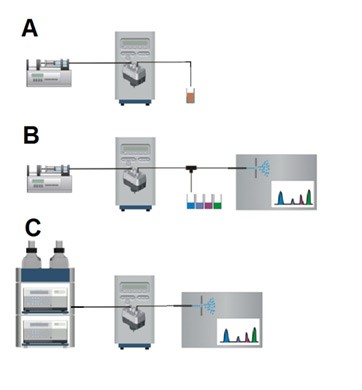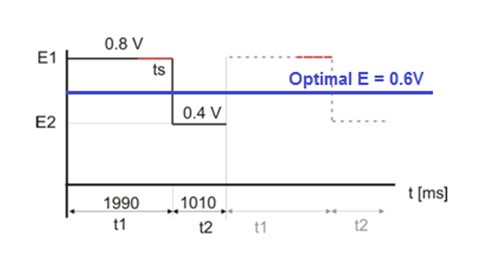µ-PREP CELL
The µ-PrepCell is specifically designed for high yields and conversion rates. Compounds passing through the flow cell are instantaneously oxidized or reduced making the cell ideally suited in on-line EC/MS or LC/EC/MS. The cell is routinely applied for in drug metabolism (generation of metabolites), protein chemistry (reduction of disulfide bonds, H/D exchange), environmental degradation, stability testing of nutrients and pharmaceuticals. In continuous infusion mode over several hours, the cell can be used for micro preparative work, generating µg quantities of REDOX products
- High yield flow cell (oxidative & reductive mode)
- Generation of metabolites, reactive intermediates, S-S bond reduction, etc.
- Ideal for on-line EC/MS, LC/EC/MS at flow rates of 20 to 100 µL/min
- Virtually zero sample adsorption
The surface area of the working electrode is approximately 10 times larger than that of the ReactorCell, a significantly higher yield is obtained using the µ-PrepCell. Since a voltage pulse is used rather than a constant voltage, highest electrochemical stability over extended working periods of up-to several hours is assured. This feature makes the cell well suited for use in post-column separation settings in Protein Chemistry and other “Omics” applications.
In the same vein, the µ-PrepCell is a powerful tool for the efficient reduction of disulfide bonds in proteins and peptides and is successfully used in LC/EC/MS settings.
Like the ReactorCell, the µ-PrepCell is based on a thin-layer flow cell concept, comprising of a very smooth working electrode surface over which the sample is flowing. This results in almost zero sample adsorption, unlike the use of a porous flow through cell which is prone to adsorption and carries over. The cell can be disassembled within a few seconds for easy cleaning of the working electrode and cell compartment. An additional advantage of using this cell in amperometric mode is the formation of intermediate reaction products including reactive metabolites, useful in the understanding and prediction of the metabolic-, biodegradation- or biotransformation pathway.
The cell is used with the ROXY Potentiostat or integrated in the ROXY EC or ROXY EC/LC system, respectively. The flow rate and working potential can be optimized using the Dialogue software or dedicated MS software (e.g., XCalibur).For maximum selectivity, yield and wide applicability, the cell is supplied with two electrode materials, Glassy Carbon (GC) and Magic Diamond™ (conductive Diamond, MD). For electrochemical reduction of Disulfide bonds in proteins/peptides a special Titanium based electrode is available. Other optional electrodes are Au and Pt.
Schematics µ-PrepCell set-up:

(A) Direct infusion mode EC/MS generating μg quantities or REDOX products with off-line
(B) and on-line MS detection
(C) and in post-column separation mode, i.e.,LC/EC/MS mode. Typical flow rates 20 to 100 μL/min.

Continuous infusion mode of Verapamil at a flow rate of 50 μL/min. MS signal recorded every 25 min. Constant yield (metabolite 1, 2 and 3) over entire sampling (synthesis) time of 3.5 hrs. For fast and efficient synthesis of large mg quantities of REDOX products the use of the Synthesis cell is recommended.

Details of the applied Pulse Mode for Verapamil Oxidation. A square wave pulse was applied close to the optimal oxidation potential (E = 0.6V) of Verapamil and repeated over time. Settings from 0.4 to 0.8 V, DE of 400 V and time durations of t1 = 1990 ms and t2 = 1010 ms were used for optimal conversion and electrode surface regeneration.
| Part no | Description |
| 204.4300 |
μ-PrepCell GC/MD, consisting of: |
| 204.4300T |
μ-PrepCell Ti, consisting of: |
| Electrodes |
|
| 204.5007 | Glassy Carbon (GC) working electrode |
| 204.5050 | Magic Diamond (MD) working electrode |
| 204.5010 | Titanium (Ti) based working electrode (S-S bond reduction) |
| 204.5027 | Gold (Au) working eletrode |
| 204.5022 | Platinum (Pt) working electrode (N-oxide formation) |
| Spare Parts |
|
| 204.0501 | O-ring inlet block, Silicone |
| 204.0503 | O-ring REF electrode, Silicone |
| 204.2217 | Spacer 50 µm |
| 204.2218 | Spacer 100 µm |

